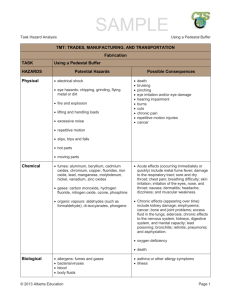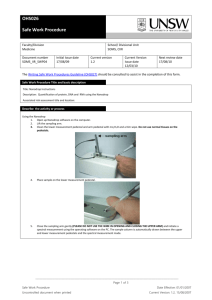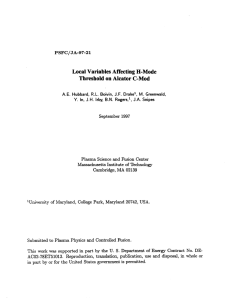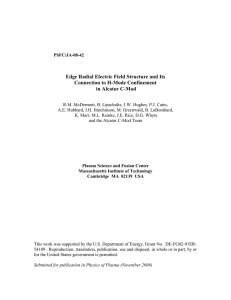Measurements of the H-mode
advertisement
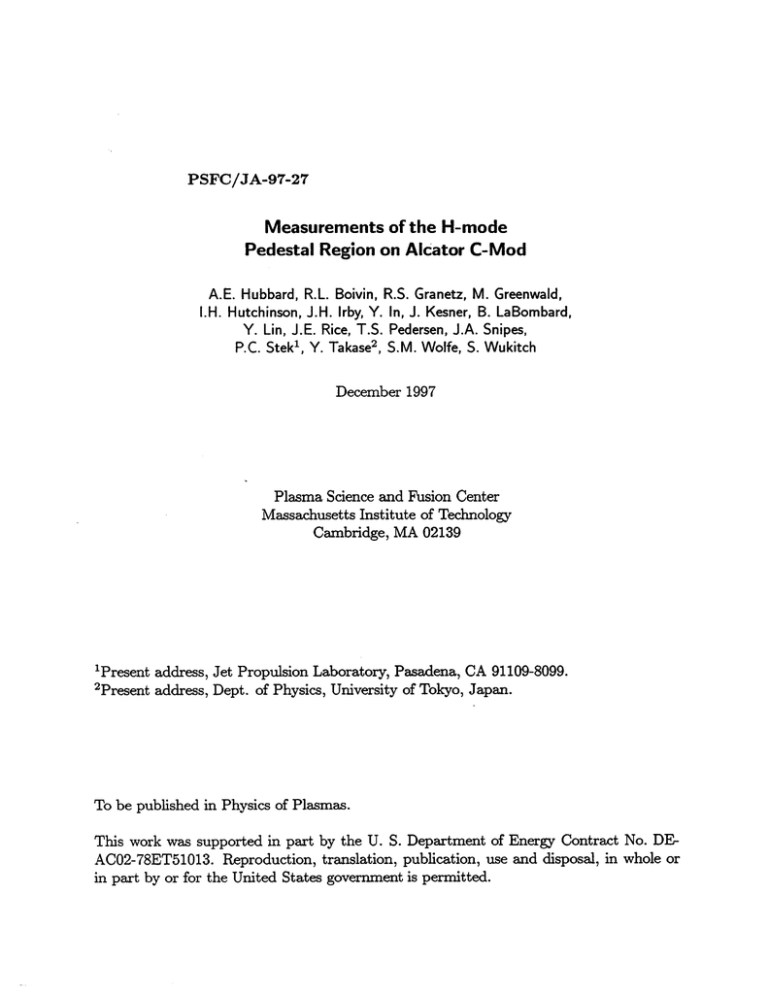
PSFC/JA-97-27
Measurements of the H-mode
Pedestal Region on Alcator C-Mod
A.E. Hubbard, R.L. Boivin, R.S. Granetz, M. Greenwald,
I.H. Hutchinson, J.H. Irby, Y. In, J. Kesner, B. LaBombard,
Y. Lin, J.E. Rice, T.S. Pedersen, J.A. Snipes,
P.C. Stek 1 , Y. Takase2 , S.M. Wolfe, S. Wukitch
December 1997
Plasma Science and Fusion Center
Massachusetts Institute of Technology
Cambridge, MA 02139
'Present address, Jet Propulsion Laboratory, Pasadena, CA 91109-8099.
Present address, Dept. of Physics, University of Tokyo, Japan.
2
To be published in Physics of Plasmas.
This work was supported in part by the U. S. Department of Energy Contract No. DEAC02-78ET51013. Reproduction, translation, publication, use and disposal, in whole or
in part by or for the United States government is permitted.
Measurements of the High Confinement Mode Pedestal Region on Alcator C-Mod
A. E. Hubbard, R. L. Boivin, R. S. Granetz, M. Greenwald, I. H. Hutchinson, J. H. Irby, Y. In,
J. Kesner, B. LaBombard, Y. Lin, J. E. Rice, T. Sunn Pedersen, J.A. Snipes, P. C. Steka),
Y. Takaseb), S. M. Wolfe, S. Wukitch
Plasma Fusion Center, Massachusetts Institute of Technology, Cambridge, Massachusetts 02139
Measurements of the steep transport barrier at the edge of the Alcator C-Mod tokamak (I. H.
Hutchinson et.al., Phys. Plasmas 1, 1511 (1994)) are presented. The parameters at the top of
this barrier are in the range Te=150-750 eV and ne = 0.5 - 3.3 x 1020m- 3 , depending on the
confinement regime. Type III Edge Localized Modes (ELMs) have an upper temperature limit.
Te pedestal profiles show a barrier width AT ~8 mm. Soft x-ray emissivity profiles are narrower,
with A =2-4 mm. Edge currents are calculated to alter the ideal stability boundary favourably,
leading to ideally stable pedestal profiles. High frequency, broadband, edge density fluctuations
are sometimes observed in H-mode and are associated with enhanced particle transport. Coherent
magnetic fluctuations localized near the pedestal are also seen.
PACS: 52.55.Fa, 52.25.Fi, 52.70.La, 52.25.Gj
) Present address, Jet Propulsion Lab, Pasadena, CA 91109-8099
b) Present address, Department of Physics, University of Tokyo, Japan
1
I. INTRODUCTION
An essential feature of the high confinement (H-mode)' regime seen on many tokamaks and
other toroidal devices is a steepening of density and temperature gradients near the separatrix.
This outer region is the first to show confinement changes, which may be followed by less dramatic
improvements in the rest of the plasma. It is also in this so-called 'pedestal' region that fluctuations
are generally observed to drop at the transition from the usual low confinement (L-mode) to the
H-mode. Stabilization of turbulence via E x B sheared flows in the edge has been proposed as an
explanation for this phenomenon 2 . Studying the pedestal region of the plasma is thus critical to
understanding both the mechanism of the L-H transition and the confinement improvement which
results from it.
The importance of parameters in the pedestal region has been underscored by transport models which predict that the core transport is substantially affected by the boundary conditions in
the outer 20% of the plasma. For example, the IFS/PPPL (Institute for Fusion Studies/Princeton
Plasma Physics Laboratory) model3 shows a strong sensitivity of core confinement to edge temperature, due to marginal stability of the ion temperature gradient mode. Results on the Alcator
C-Mod tokamak4 (C-Mod) have shown a good correlation between the edge temperature and the
global energy confinement, which holds for both L and H-mode plasmas5 . The core temperature
gradients also increase with edge temperature, consistent with a marginally stable transport situation. It should be noted that while transport theories are mainly sensitive to the ion temperature
Ti, at the high densities typical of C-Mod electron and ion temperatures are expected to be tightly
coupled, especially near the plasma edge.
The pedestal region is less well understood than the core plasma, leading to significant uncertainties in predicting the boundary conditions for future machines. Recently, diagnostic advances
have made possible more detailed measurements of the edge transport barrier. DIII-D6 reports electron pressure widths which scale equally well with (p,,j/R)0 . s or with (0p,,j)
0
, where both the
ion poloidal gyroradius pip,,ol and the edge poloidal beta are calculated at the top of the pedestal7 .
JT-60U 8 reports that the width of the barrier in T varies linearly with pi,poi 9 . On the other hand,
recent results from the Axisymetric Divertor Experiment (ASDEX) Upgrade' 0 indicate little or no
dependence of the width of the barrier in Te on pi,pol3.
2
H-modes have been observed on Alcator C-Mod(R = 0.67 m, a = 0.22 m, K < 1.8) at magnetic
fields in the range 2.6-7.9 T, plasma currents I, of 0.6-1.2 MA and at line averaged density We
up to 4.8 x 1020 m- 3 . H-modes are either ohmic or heated by up to 3.5 MW of ion cyclotron
resonance heating (ICRH)' 2 . Lower triangularity is typically 0.5-0.6, while the upper triangularity
is 0.3-0.8. The experiments thus cover a unique parameter space, particularly in BT and density.
Measurements on C-Mod aim to help resolve the present uncertainty regarding the relevant variables
and scalings which determine both the pedestal height and width.
Many H-modes on Alcator C-Mod are ELM-free, that is they do not exhibit any 'Edge
Localized Modes', or ELMs' 3 . Type III ELMs are sometimes, but not usually, seen. We have
never observed the regular, large, 'Type I ELMs reported by most other tokamaks at high heating
power. An H-mode regime has been found on C-Mod which shows lower particle and impurity
confinement than ELM-free H-mode, leading to steady state conditions, while still maintaining
good energy confinement'"
2
. These confinement properties are reminiscent of ELMy H-modes on
other machines. However, in this regime there are no signatures of discrete ELMs, which elsewhere
cause concerns about instantaneous heat flux to the divertor. Rather, the level of edge D, emission
rises steadily, leading to the name 'Enhanced D,' (EDA) H-mode". Understanding this regime is
a priority given the potentially attractive features for reactor operation.
Previous analysis of parameters in the outer region of Alcator C-Mod plasmas has concentrated on characterizing conditions just before the L-H and H-L transitions in a variety of core
plasma conditions'2,1,"
6
,17 ,'.
It has been found that, for a given magnetic configuration, a min-
imum value of edge electron temperature, or its gradient, is required to enter H-mode. The H-L
transition occurs at a temperature which is the same as or higher than the L-H threshold; there
is thus no favourable hysteresis in this local threshold condition. The threshold T shows a strong
positive dependence on BT and a density dependence which can be either flat or weakly negative.
When the toroidal field and current were reversed, giving ion B x VB drifts pointing away from the
active lower divertor, both the edge threshold temperature and the global power threshold doubled.
Comparisons with theory show that for the favourable drift direction, our measured thresholds are
roughly consistent with thresholds in dimensionless ballooning and ion diamagnetic parameters
predicted by numerical simulations of turbulence suppression via sheared E x B flow, carried out
3
by Rogers and Drake' 8 " 9 . The differences with reversed field are not yet understood, but may
imply a role of scrape-off layer (SOL) flows.
This paper will focus on measurements of plasma parameters in the pedestal region during
the H-Mode. The diagnostic set used for pedestal measurements on C-Mod will be described in the
following section. In section III, the parameters near the top of the transport barrier in the various
H-Mode regimes will be presented. Measurements of the structure and width of H-mode pedestals
will be shown in Section IV. These enable an analysis of the MHD stability of the pedestal, given
in Section V. Conclusions and plans for future studies are given in the final section.
II. DIAGNOSTICS
Edge studies on C-Mod have concentrated on electron density and temperature since these
are the parameters for which the best diagnostic information is available. The primary density
profile diagnostic is an interferometer with 10 vertical chords2 0 . However, the chords are not
located close to the separatrix, so that assumptions must be made about the edge density in the
inversion process. A parametrization based on probe measurements of the SOL is used. More
detailed information on the edge density and its fluctuations is obtained from reflectometry 2 l. Five
amplitude-modulated channels operating in the ordinary mode probe density layers between 0.3
and 1.5 x 1020 m
3
. The absolute calibration of the position of each reflecting layer is estimated
at ± 5 mm. The reflectometer has a time resolution of 0.5 msec for profile measurements. Rapid
digitization of the 88 GHz channel has been used for some discharges to monitor changes in the
level of density fluctuations at the critical density layer with bt = 2.4 pts.
Electron temperature profiles on C-Mod are measured by electron cyclotron emission (ECE)
spectrometers. For pedestal studies, a nine channel grating polychromator (GPC) is used. This
provides Te(t) at 9 magnetic fields (radii) with instrument-limited frequency resolution giving
6R(FWHM) of typically 9 mm. For the experiments reported here, a digitization rate of 20 kHz
was used. Absolute calibration uncertainties are estimated to be ±10%, with lower random noise
levels (typically 10 eV). A Thomson scattering system measures at 6 positions with 20 ms time
resolution, and generally gives central Te in good agreement with ECE. However, its spectrometers
are not well optimized for the cooler temperatures (< 0.8 keV) typical of the edge pedestal.
Two new diagnostics were added in 1997 specifically to provide higher radial resolution in
4
the pedestal region. A 38-chord x-ray array views the edge region of the C-Mod plasma with 1.5
mm radial resolution, and 12 ps temporal resolution. A 10 micrometer thick beryllium foil cuts out
all photon energies below 600 eV. The chord-integrated data from the edge x-ray array have been
inverted to get edge emissivity profiles as a function of time. The edge radiated power emissivity is
measured using a silicon AXUV diode array which possesses a very thin dead layer on its surface,
allowing a flat response across a wide range in photon energies, at least from 20-4000 eV. The array
is composed of 19 channels spanning approximately 4 cm near the separatrix, with 2 mm spatial
resolution and a better than 100 ps time resolution.
C-Mod also has a full set of scrape-off layer and divertor diagnostics
22
. A scanning Langmuir
probe, inserted from the bottom of the vessel well away from the divertor region, can reach close
to the separatrix. ne and T profiles are measured with a scan time of 40 ms and ~ 0.5 mm radial
resolution. These data are important since we find that the transport barrier extends a small
distance into the SOL.
To aid in comparison of the different diagnostics used, all data are referenced to surfaces of
normalized poloidal flux
4.
Radii are then mapped to the outer horizontal midplane. Equilibrium
reconstruction based on magnetics diagnostics is carried out by the EFIT code 23 . Accuracy in
determining the resolution of the last closed flux surface (LCFS) is estimated at ± 3 mm.
III. OPERATIONAL SPACE OF EDGE PEDESTAL PARAMETERS
Parameters near the edge of the plasma have been compiled for a large number of H-mode
discharges. We generally take the point at V) =95%, which has been found in detailed profile
measurements to be at or slightly inside the top of the pedestal. As discussed above, inverted edge
densities from the interferometer have relatively large uncertainties. The derived pedestal density
is typically 70% of -fe in both L and H-mode, and may underestimate the actual density in H-mode.
Plotting edge temperature vs edge density has been found to be a useful way of characterizing
the 'operation space' of different confinement regimes". Figure 1 shows such a plot for over 400
time slices taken from a wide variety of C-Mod discharges with BT ~5.3 T and Ip=0.8-1.2 MA.
Conditions are not necessarily in steady state at the times chosen. As can be seen, a wide space is
essentially filled in, with edge densities from 0.4-3 x 1020 m- 3 and temperatures from 50 to 750 eV.
Even higher H-mode pedestal densities, up to 3.3x10 20 m-3, have been achieved. However, ECE
5
emission at the frequency of interest for this field is cut off at 3.1 x 1020 m-3 so that edge Te is
no longer measured. While there is some overlap, the different regimes do tend to separate in this
space. As was found in threshold studies, L-mode points have Te(ik = 0.95) < 150 eV, with the
exception of a few discharges below our low density limit for H-mode, ife ~ 0.7 - 0.9 x 1020 m- 3 .
Type III ELMs occur when the pedestal temperature is only slightly above the L-H threshold,
up to 200 eV. They are identified by transient increases in D. and by MHD signatures including
high m and n precursors
6
. Above this temperature, which does not show a density dependence,
ELMs consistently disappear, suggesting stabilization of the responsible mode. The existence of
an upper temperature for Type III ELMs has been seen elsewhere 7 2 4 and has been suggested as
evidence that these ELMs are due to a resistive instability 3 . Measurements of the threshold on
different machines can help to distinguish between possible models. A scaling for stabilization of a
flute dissipative instability predicted ELMs would be seen up to 500 eV at this field on C-Mod 25 ,
which disagrees with our observations. Operationally, Type III ELMs tend to occur either for
discharges with input power not far above the L-H threshold or in cases with high radiated power,
which cools the edge. In high power, well conditioned discharges the pedestal temperature quickly
rises above 200 eV and at most a few ELMs are seen.
Most C-Mod discharges remain ELM-free for nearly the whole duration of the H-mode.
After the initial rise in pedestal temperature and density, the core density typically continues
to rise throughout the ELM-free phase. The increases in density and in impurity radiation, due to
greatly increased particle and impurity confinement 26 , eventually cause the pedestal temperature
and confinement to drop. The ELM-free regime has given the highest pedestal temperatures, up to
750 eV, and correspondingly the best confinement enhancement factor, HITER89-p (or simply the
'H factor') up to 2.5. This is defined as the ratio of the observed confinement time to that predicted
by the ITER89-P L-mode scaling law27 . Its main operational disadvantage is that conditions are
not steady state. As seen in Figure 1, there is a wide variation in Tedge in ELM-free discharges even
for nominally similar conditions. It tends to decrease with higher radiated power fraction, as might
be expected. The correlation of Tdge with net conducted power is, surprisingly, not as strong.
The Enhanced D, regime has pedestal temperatures which typically are more modest than
the best ELM-free cases, but can still be up to 650 eV. Average energy confinement is also reduced
6
by -10%, with H-factors of 1.5-2.3. This loss is offset by the considerable decrease in particle and
impurity confinement, which enables steady state conditions to be maintained with a moderate
level of radiation (Prad/P
30%). While there are typically no signatures of discrete ELMs,
high frequency density and sometimes magnetic fluctuations are seen to increase 28 . These will
be described in more detail later. From the edge operational space plot, it can be seen that
while EDA H-modes tend to occur at high densities [ne(0 = 0.95) > 1.5 x 1020 m- 3 ], the edge
parameters overlap those of the ELM-free discharges. This makes it unlikely that the EDA is
simply a manifestation of a pressure limit similar to that seen for Type I ELMs 7".
The regime
persists at temperatures well above those characteristic of L-Mode or Type III ELMs.
The edge density and temperature for plasmas with BT = 8 T, shown in Figure 2, exhibit
a similar separation of regimes to that found at 5.3 T. Fewer experiments to date have been run
at this field, which uses a D(He3 ) ICRF heating scenario having lower single pass absorption than
the D(H) scheme used at 5.3 T. The power threshold increases with BT, so that H-mode can be
obtained over a more limited density range and most discharges had power close to the threshold.
Pressures are probably limited by the available input power. Higher edge temperatures are seen
in L-mode, reflecting the higher local transition threshold. Type III ELMs also occur at higher
temperature, up to 350 eV. Most 8 T H-modes are ELM-free, but a few discharges with weakly
enhanced Dc have been observed.
IV. MEASUREMENTS OF PEDESTAL WIDTH
Detailed measurements of the H-mode pedestal region are available for a more limited set
of discharges. The density at the plasma edge is seen by the reflectometer to rise very rapidly at
the transition. Fig. 3 shows profiles 10 ms before and after a transition from L-mode to ELM-free
H-mode. Thomson scattering data, also shown, indicate little change in the core density during
this early period. All of the reflectometer channels move close to the separatrix in H-mode, their
separation less than the absolute position uncertainty of 1 cm. In fully developed H-modes, the top
of the density pedestal typically exceeds the maximum cutoff density of the reflectometer and only
the lower part of the pedestal can be covered. In this outer region the density fluctuations drop
dramatically at the transition from L-mode to an ELM-free H-mode. At the transition to the EDA
regime, in all cases where sufficiently fast data are available, broadband density fluctuations in the
7
range 50-200 kHz start to increase simultaneous with the rise in D,, emission2 8 . This suggests
that these fluctuations may be associated with the increased particle transport. The fluctuation
spectrum often, but not always, has a peak at ~ 50-140 kHz.
Langmuir probe data show that electron density profiles, as well as temperature profiles,
steepen just outside the separatrix. Figure 4 shows profiles taken in two similar 800 kA, 5.3 T
discharges. One is just before an L-H transition, and the other late in an ELM-free H-mode. Both
ne and Te drop outside the separatrix and start to increase about 1 mm from the separatrix. Scale
lengths LT = Te/VT and Ln = ne/Vne both decrease from 5 mm to 2 mm, and the apparent
transport barrier extends several mm into the scrape-off layer. Further details of SOL transport on
C-Mod have been reported previously22 .
The pedestal in Te is less than the channel separation of the GPC (-
2 cm), so that in
normal operation details of the pedestal cannot be resolved. A technique of sweeping the toroidal
field by 2-3 % has been used to move the radial positions of the channels across the pedestal during
a discharge. This had no discernable impact on the plasma behaviour or RF coupling, whereas
sweeping the plasma position would significantly perturb the discharge. The BT ramp takes ~ 80
ms, so the technique is best suited to steady state regimes. Figure 5 shows an example from a 5.3
T, 800 kA EDA H-mode discharge with 71e = 2.7 x 1020 m- 3 and PRF = 2.4 MW. The pedestal
in this case is 425 eV and has a well defined steep gradient region. The temperature at RLCFS
agrees well with an estimate of 125 eV based on parallel heat conduction in the SOL, and shows
no evidence of non-thermal emission. The radiation temperature of 60 eV seen well outside the
separatrix is due to first harmonic emission (expected for R - RLCFS > 1 cm) and possibly to a
small spurious response to higher diffraction orders in the grating polychromator.
In order to determine the pedestal width, the measured ECE profile is fit by a tanh function
as suggested by the DIII-D group2 9 , defined as T(R) = A{tanh[(Rped - R)/6] + 1} + T0,.t, where
Rped
is the location of the pedestal midpoint, 6 = A/2 is the half-width of the pedestal and T,,
is the observed offset. For R < (Rped - 6), a linear term C(Rped - 6 - R) is added. This gives a
good fit to the ECE data and results in a full width A=12 mm (dashed curve). While sweeping
the channel position gives a large number of measurement points, the emission at each time is
still subject to the instrumental radial resolution (FWHM=9 mm). Deconvolving the instrument
8
function gives a narrower actual pedestal width
AT
= 8mm (solid curve). The maximum gradient
is 40 keV/m, as compared to 8 keV/m further inside the plasma. Since this width is comparable
to the resolution, it is considered an upper bound.
The pedestal width on C-Mod is clearly narrower than on other tokamaks, making measurements in this region more challenging. For comparison, pedestal widths of ~ 3-6 cm are reported
on JET3 0 ,3 1 , 0.7-2 cm on DIII-D7 , 2-2.6 cm on ASDEX Upgrade" and 2-7 cm on JT-60U 9 . The
higher resolution of the new x-ray and AXUV arrays is thus needed to characterize this region. The
power emissivity measured by the AXUV array, similar to the profiles measured by probes, drops
outside the separatrix at the L-H transition and increases steeply inside it, as shown in Figure 6.
The scale length E/(d/dR) decreases from ~15 mm to 4 mm. The high resolution profile extends
1 cm inside the separatrix, and does not show any decrease in slope which would indicate the top
of a transport barrier. Emissivity is a function of temperature and impurity density as as well as
ne, and lower resolution bolometry and XUV diode measurements show that radiated power peaks
at r/a ~ 0.85 during H-mode, dropping in the core. A pedestal structure corresponding to that in
Te(R) or ne(R) is thus not expected.
The edge x-ray emissivity, in contrast, does show a very clear pedestal which develops at
the L-H transition. The peak emissivity rises from 4 kW/m
shown in Figure 6, and up to 60 kW/m
3
3
to 26 kW/m
3
for the same discharge
in some cases. The inverted emission profiles, shown in Fig.
7, increase over only 2 radial points, which have a separation of 1.7 mm, and the apparent position
of this pedestal is 1 cm inside the separatrix. A tanh fit gives widths A, of 3 to 4 mm, varying
slightly with time. Widths as small as 2 mm have been measured on some similar discharges.
The interpretation of the x-ray emissivity in terms of plasma temperature and density is
unfortunately not straightforward. Bremsstrahlung and recombination of low Z impurities can
account for only ~5 kW/m 3 under these conditions. A substantial fraction may thus be due to
impurity line emission, which can be a strong function of temperature. However, spectrally resolved
x-ray measurements in the range 3.7-4.0
A
show no evidence of lines from species such as Ar or
Mo near the edge. Spectra at lower energies will be required in order to identify the x-ray sources.
The x-ray filter function has decreasing transmission for energies typical of pedestal temperatures.
For these reasons, the pedestal in emissivity will tend to be narrower than the T or ne pedestals
9
and at a position shifted in the direction of hotter plasmas.
An empirical fit, comparing the time behaviour of the peak emission to that of the pedestal
temperature and density, shows that the emissivity is well approximated by
=
n exp(Te/Ti),
where T1 ~ 100 eV. Applying this function to the radial profiles, and assuming that T and ne have
tanh profiles with the same width and position (which is not certain), one can model the emission
which would result from different profiles. We find that the x-ray pedestal would have a width
A, which is 30% narrower and is shifted inward by AT/2. The measured emission would then be
consistent with an actual pedestal width of ~ 5 mm. Analysis of other discharges gives a range of
3-6 mm. This interpretation places a lower bound on the pedestal width for ELM-free H-Modes
on C-Mod (BT=5.4 T), but is considered preliminary pending a more complete identification and
modelling of the sources of x-ray emission.
V. MHD STABILITY
Details of the pedestal profiles are critical to assessing the MHD stability of various modes
near the plasma edge. As can be seen from the operational space diagram, C-Mod H-modes have
a wide range of pedestal parameters. MHD analysis has therefore concentrated on the discharges
closest to the constant pressure line shown in Figure 1, which are expected to be most unstable.
Since we do not yet have high resolution measurements for the discharges with the highest pedestals,
the width measurements given in section IV have been used to estimate the edge pressure gradients.
Figure 8 shows the ideal ballooning stability analysis for a 5.4 T, 1 MA Enhanced D,, H-mode
plasma. The discharge has an edge temperature similar to the one shown in Figure 5, but has higher
ICRF power (3.5 MW), and density (7ie = 3.8 x 1020 m- 3 ), and therefore higher pressure. The
pressure gradient P' = dP/db is calculated using the experimental Te and n, values at R = 0.86
m, and assuming a shape similar to the tanh function with A = 8 mm measured for Te(R). T;(R) is
derived using the central Ti measured by neutron diagnostics and adjusting Ti/Te according to the
computed electron-ion equilibration rate at each radius. For this discharge T(0) ~ 0.9 Te(0), and Ti
is very close to Te at the edge. T profiles derived using this method agree well with high resolution
x-ray spectroscopy data in cases when these are available. The maximum total pressure gradient
dP/dR = 5.9 x 106 Pa/m near the separatrix, which corresponds to P' = 7.5 x 101 Pa/Wb/rad
in flux coordinates. This kinetic pressure profile is self-consistently included in the equilibrium
10
reconstruction carried out by EFIT, which is then analysed by the BALOO code32 . The resulting
ideal stability boundary Pi,.i, shown by the thick solid curve, starts to increase at 0 > 0.95, the
region of steep gradient. This is due to an increase in the deduced edge current, which is consistent
with calculated bootstrap current and which significantly modifies the shear profile. A small region
of 'second stable access' appears for 0 > 0.98. The pressure profile in this case is found to be
stable everywhere. In order to illustrate the effect of the edge gradient, the dotted curve shows
the stability boundary calculated assuming that there is no pressure pedestal, simply extrapolating
the core pressure gradient to the edge and hence avoiding the edge bootstrap current. In this case
IP',it decreases slightly towards the edge and the 'second stable access' disappears. Qualitatively
similar stability results have been reported for parameters typical of DIII-D discharges3 2 .
Given the proximity to the ideal limit, one might expect that pressure profiles would need
to be only 30% narrower in order to exceed the stability limit. However, if steeper gradients are
assumed in the reconstruction the stability boundaries shift, in a favorable direction, as the edge
current also increases. The edge profiles remain ideal ballooning stable for P' up to 1.4 x 107
Pa/Wb/rad, which is equivalent in maximum gradient to a pedestal width of A ~ 4 mm. This
marginal case, which would be consistent with the width estimated from x-ray data, is shown by
the dashed curves in Fig. 8. Cases with even higher gradients do become unstable. Ideal stability
is consistent with the lack of type I ELMs in C-Mod operation to date. The available RF input
power on C-Mod will be doubled to 7 MW in 1998, and it will be of interest to learn to what extent
pedestal pressures can be increased before encountering an MHD limit. It is clear that stability
calculations are sensitive to details of temperature and density profiles which are at the limit of
our present diagnostic capability. It is essential to include kinetic pressure in full equilibrium
reconstructions when performing such stability analysis.
Another topic of interest is determining the cause of the fluctuations seen during our Enhanced D, regime. In addition to the broadband density fluctuations mentioned in Section III,
coherent fast fluctuations, which may be bursting or continuous, are often seen on magnetics diagnostics. These fluctuations, referred to as the 'Fast Edge Mode'", have n=1 and m=4 or 5,
depending on whether the q=4 or 5 rational surface is located in the pedestal region. They are presumably caused by an edge instability. The peak frequency of 60-90 kHz would imply perpendicular
11
velocities of ~ 5 x 10
4
m/s, exceeding the diamagnetic drift velocity even for the steepest estimates
of the pressure gradient, which suggests that additional poloidal rotation may be present. Magnetic
fluctuations have similar amplitudes (~
5 x 10-') on the high and low field side, indicating that
they are not ballooning in nature. The spectra of density and magnetic fluctuations have similar
frequency ranges but do not show a statistical correlation. While the Fast Edge Mode does cause
small rises in D, emission, it is not observed in all EDA phases and has occasionally been seen
during ELM-free periods. It thus does not appear to be the primary cause of the increased particle
transport.
The location of the Fast Edge Mode near a rational surface has led to the investigation of
tearing and microtearing modes as possible explanations 2 8 ,'.
In a steep pedestal, either the current
gradient j' or the temperature gradient VT could be destabilizing. When the rational surfaces
are located within the pressure pedestal, several radial eigenmodes of the VT driven micro-tearing
mode have been calculated to become linearly unstable for LT = Te/VTe ~ 5 mm, consistent with
the profile shown in Figure 5. Calculations indicate that the m/n=4/1 mode is unstable and that
higher m modes can also become unstable as the pedestal approaches the separatrix.
VI. CONCLUSIONS AND FUTURE PLANS
Measurements to date of the pedestal region on C-Mod, using an extensive diagnostic set,
have shown the existence of a steep transport barrier in both temperature and density in HMode. The parameters at the top of this barrier cover a wide operational space (Te=150-750 eV,
n, = 0.5 - 3.3 x 1020 m-3), depending on the global plasma parameters, input and radiated powers
and H-mode regime. Type III ELMs are only seen for Te (0 = 0.95) below 200 eV at 5.4 T and 350
eV at 8 T. ELM-free H modes have the highest pedestal temperatures, but tend to be transient.
Steady-state Enhanced D, H-modes generally have slightly lower pedestals in Te, but can have
comparable pedestal pressures since they occur at high density.
Edge density profiles are observed by both the reflectometer and Langmuir probes to steepen
in H-mode. The ne barrier width is < 1 cm, within our diagnostic resolution. Te pedestal profiles
show a barrier width AT ~8 mm , again close to the diagnostic resolution. Soft x-ray profiles show
even narrower profiles, with A =2-4 mm. The sources of x-ray radiation are not yet determined, but
preliminary analysis indicates these profiles would be consistent with AT ~ An ~3-6 mm. MHD
12
stability analysis shows that edge currents associated with the pedestal favourably alter the ideal
stability boundary, leading to a narrow region which apparently has 'second stable access'. Because
of these effects, edge pressure profiles are found to be ideally stable, consistent with the observed
absence of Type I ELMs, despite very steep gradients. High frequency fluctuations located in the
pedestal region are sometimes observed. Incoherent, broadband density fluctuations increase in
the Enhanced D, H-mode and may be responsible for the increased particle transport. Coherent
magnetic fluctuations are sometimes seen, and are associated with rational surfaces within the
pedestal. Their high frequency suggests that poloidal rotations may be large.
In future experiments, profile widths will be measured under a wider range of plasma conditions. In particular, it is hoped to establish the scaling with plasma current, magnetic field and
density, as well as to compare ELM-free and EDA H-modes. This should help resolve uncertainties
about the dependence on pi and pipol as well as other possible variables such as neutral penetration. The narrow widths measured by the edge soft x-ray array imply that temperature and
density profile diagnostics with 6R ~ 1 mm are required to resolve details of the pedestal region. A
pedestal Thomson scattering system and heterodyne radiometer are being designed. A diagnostic
neutral beam to be installed in 1998 will make possible CXRS measurements of T(R) and rotations as well as MSE measurements of current profiles. Other spectroscopic diagnostics are also
beginning to measure edge rotations. These quantities will enable us to infer the edge electric field,
and should help to give a more complete understanding of the formation and sustainment of the
H-mode transport barrier.
Acknowledgments
This work was supported by the United States Department of Energy Contract No. DEAC02-78ET51013. The efforts of the entire C-Mod technical, operations and physics groups in
carrying out these experiments are gratefully acknowledged.
13
References
' ASDEX Team, Nucl. Fusion 29 (11), 1959 (1989).
2
K. H. Burrell,Phys. Plasmas 4 (5) (1997).
3 M. Kotschenreuther, W. Dorland, M.A. Beer, G.W. Hammett, Phys. Plasmas 2 (6), 2381, (1995).
1 I. H. Hutchinson, R. Boivin, F. Bombarda, P. Bonoli, S. Fairfax, C. Fiore, J. Goetz, S. Golovato, R.
Granetz, M. Greenwald, S. Home, A. Hubbard, J. Irby, B. LaBombard, B. Lipschultz, E. Marmar,
G. McCracken, M. Porkolab, J. Rice, J. Snipes, Y. Takase, J. Terry, S. Wolfe, C. Christensen, D.
Garniew, M. Graf, T. Hsu, T. Luke, M. May, A. Niemczewski, G. Tinios, J. Schachter, J. Urbahn,
Phys. Plasmas 1, 1511 (1994).
5 M. Greenwald, R. L. Boivin, F. Bombarda, P. T. Bonoli, C. L. Fiore, D. Gamier,
J. A. Goetz,
S. N. Golovato, M. A. Graf, R. S. Granatz, S. Horne, A. Hubbard. I. H. Hutchinson, J. H. Irby,
B. LaBombard, B. Lipschulz, E. S. Marmar, M. J. May, G. M. McCracken, P. O'Shea, J. E. Rice,
J. Schachter, J. A. Snipes, P. C. Stek,Y. Takase, J. L. Terry, Y. Wang, R. Watterson, B. Welch,
S. M. Wolfe, Nucl. Fusion Vol. 37, No. 6, 793 (1997).
6 J. L. Luxon, R. Anderson, F. Batty, C. B. Baxi, G. Bramson, N. H. Brooks B. Brown and the DIII-
D Team, in Plasma Physics and Controlled Nuclear Fusion Research, 1986 (International Atomic
Energy Agency, Vienna, 1987), Vol. 1, 159.
'
T. H. Osborne, R. J. Groebner, L. L. Lao, A. W. Leonard, R. Maingi, R. L. Miller, G. D. Porter,
D. M. Thomas and R. E. Waltz, Proc. 24th EPS Conf. on Controlled Fusion and Plasma Physics,
Berchtesgaden, Germany, 1996, (European Physical Society, Petit-Lancy) Vol. 21A, 1101 (1997).
8
JT-60 Team, in Proc. 14th Conf. on Plasma Physics and Controlled Nuclear Fusion Research,
1992 (International Atomic Energy Agency, Vienna, 1987), Vol. I, 57.
9 M. Kikuchi, M. Sato, Y. Koide, N. Asakura, T. Fukuda, S. Ishida, M. Mori, M. Shimada, H.
Ninomija, Proc. 20th EPS Conf. on Contr. Fusion and Plasma Physics, Lisboa, 1993, (European
Physical Society, Petit-Lancy) Vol. 17C, 179 (1993).
10 W. Koppendorfer, C. Andelfinger, M. Ballico, and the ASDEX Upgrade and NBI Teams, in Proc.
14th Conf. on PlasmaPhysics and ControlledNuclear FusionResearch, 1992 (International Atomic
Energy Agency, Vienna, 1993), Vol. 1, 127.
"
W. Suttrop, 0. Gehre, J. C. Fuchs, H. Reimerdes, W. Schneider,J. Schweinzer, ASDEX Upgrade
14
team, "Effects of Type I Edge Localized Modes on Transport in ASDEX Upgrade", IAEA Technical
Committee Meeting on H-modes, Kloster Seeon, Germany, Sept. 1997, submitted to Plasma Phys.
and Contr. Fusion.
1
Y. Takase, R.L. Boivin, F. Bombarda, P.T. Bonoli, C. Christensen, C. Fiore, D. Garnier, J.A. Goetz,
S.N. Golovato, R. Granetz, M. Greenwald, S.F. Horne, A. Hubbard, I.H. Hutchinson, J. Irby,
B. LaBombard, B. Lipschultz, E. Marmar, M. May, A. Mazurenko, G. McCracken, P. O'Shea,
M. Porkolab, J. Reardon, J. Rice, C. Rost, J. Schachter, J.A. Snipes, P. Stek, J. Terry, R. Watterson,
B. Welch, S. Wolfe, Phys. Plasmas 4 1647 (1997).
'
H. Zohm, Plasma Phys. Control. Fusion 38, 105 (1996).
14
Y. Takase, R. Boivin, F. Bombarda, P.T. Bonoli, C. Fiore, D.
Garnier, J. Goetz, S. Golovato,
R. Granetz, M. Greenwald, S.F. Home, A. Hubbard, I. Hutchinson, J. Irby, B. LaBombard, B. Lipschultz, E. Marmar, M. May, A. Mazurenko, G. McCracken, P. O'Shea, M. Porkolab, J. Reardon,
J. Rice, C. Rost, J. Schachter, J.A. Snipes, P. Stek, J. Terry, R. Watterson, B. Welch, S. Wolfe,
in Proc. 16th Int. Fusion Energy Conf., Montreal, 1996, (International Atomic Energy Agency,
Vienna, 1997), Vol. I, 475.
13 J.A. Snipes, R.L. Boivin, C. Christensen, D. Ganier, J. Goetz, S.N. Golovato, M. Graf, R.S.
Granetz, M. Greenwald, I.H. Hutchinson, J. Irby, B. LaBombard, E.S. Marmar, A. Niemczewski,
P.J. O'Shea, M. Porkolab, P. Stek, Y. Takase, J.L. Terry, M. Umansky, S.M. Wolfe, Phys. Plasmas
3, 1992 (1996).
16
J.A. Snipes, A.E. Hubbard, D.T. Garnier, S.N. Golovato, R.S. Granetz, M. Greenwald,
I.H.
Hutchinson, J. Irby, B. LaBombard, E.S. Marmar, A. Niemczewski, P.J. O'Shea, M. Porkolab,
P. Stek, Y. Takase, J.L. Terry, R. Watterson, S.M. Wolfe, Plasma Phys. Control. Fusion 38, 1127
(1996).
17
A. E. Hubbard, J. A. Goetz, I. H. Hutchinson, Y. In, J. Irby, B. LaBombard, P. J. O'Shea, J. A.
Snipes, P. C. Stek, Y. Takase, S. M. Wolfe, Alcator Group, in Proc. 16th Int. Fusion Energy Conf.,
Montreal, 1996, (International Atomic Energy Agency, Vienna, 1997), Vol. I, 875.
18 A. E. Hubbard, R. L. Boivin, J. F. Drake, M. Greenwald, Y. In, J. H. Irby, B. N.
Rogers and
J. A. Snipes,"Local Variables Affecting H-mode Threshold on Alcator C-Mod", IAEA Technical
Committee Meeting on H-modes, Kloster Seeon, Germany, Sept. 1997, submitted to Plasma Phys.
15
and Contr. Fusion.
19 B. N. Rogers and J. F. Drake, Phys. Rev. Letters 79 229 (1997).
20
J. H. Irby, E. S. Marmar, E. Sevillano, S. M. Wolfe, Rev. Sci. Instrum. 59(8) 1568 (1988).
21
P. C. Stek, Reflectometry Measurements on Alcator C-Mod, PhD thesis, Mass. Inst.
of Tech., 1997.
22
B. LaBombard, J.A. Goetz, I. Hutchinson, D. Jablonski, J. Kesner, C. Kurz, B.
Lipschultz, G.
M. McCracken, A. Niemczewski, J. Terry, A. Allen, R.L. Boivin, F. Bombarda, P. Bonoli, C.
Christensen, C. Fiore, D. Garnier, S. Golovato, R. Granetz, M. Greenwald, S. Horne, A. Hubbard,
J. Irby, D. Lo, D. Lumma, E. Marmar, M. May , A. Mazurenko, R. Nachtrieb, H. Ohkawa, P.
O'Shea, M. Porkolab, J. Reardon, J. Rice, J. Rost, J. Schachter, J. Snipes, J. Sorci, P. Stek, Y.
Takase, Y. Wang, R. Watterson, J. Weaver, B. Welch, S. Wolfe, J. Nucl. Mat. 241-243 (1997) 149.
23
L.L. Lao, H. St. John, R.D. Stambaugh, A.G. Kellman, W. Pfeiffer, Nucl. Fus. 25 (1985)
1611.
24
H. Zohm, W. Suttrop, H.J. DeBlank, R.J. Buttery, D. A. Gates,
J.A. Heikkinen, W. Herrmann,
A. Kallenback, T. Kass, M. Kaufmann, T. Kurki-Sonio, B. Kurzan, M. Maraschek, H. Reimerdes,
F. Ryter, H. Salzmann, J. Schweinzer, J. Stober, ASDEX Upgrade, ECRH, ICRH, NBI Teams,
in Proc. 16th Int. Fusion Energy Conf., Montreal, 1996, (International Atomic Energy Agency,
Vienna, 1997), Vol. I, 439.
25
G. Janeschitz, A. Hubbard, Y. Igitkhanov, J. Lingertat, T. Osborne,
H. D. Pacher, 0. P. Pogutse,
D.E. Post, M. Shimada, M Sugihara, W. Suttrop, Proc. 24th EPS Conf. on Controlled Fusion
and Plasma Physics, Berchtesgaden, Germany, 1996, (European Physical Society, Petit-Lancy) Vol.
21A, 1101 (1997).
26 J. E. Rice, J. L. Terry, J. A. Goetz, Y. Wang, E. S. Marmar, M. Greenwald, I.
Hutchinson, Y.
Takase, S. Wolfe, H. Ohkawa, A. Hubbard, Phys. Plasmas 4 (5) 1605 (1997).
27
P. G. Yushmanov, T. Takizuka, K. Riedel, 0. Kardaun, J. Cordey, S. Kaye, D. Post, Nucl.
Fusion
30, 1999 (1990).
28 J. A. Snipes, R. S. Granetz, M. Greenwald, A. E. Hubbard,
I. H. Hutchinson, J. Irby, J. Kesner,
S. Migliuolo, T. S. Pedersen, J. Ramos, J. Rice, P. C. Stek, Y. Takase and S. M. Wolfe, "ELMs
and fast edge fluctuations in Alcator C-Mod", IAEA Technical Committee Meeting on H-modes,
Kloster Seeon, Germany, Sept. 1997, submitted to Plasma Phys. and Contr. Fusion.
29
R. J. Groebner and T. N. Carlstrom, "Critical Edge Parameters
for H-Mode Transition in DIII-D",
16
IAEA Technical Committee Meeting on H-modes, Kloster Seeon, Germany, Sept. 1997, submitted
to Plasma Phys. and Contr. Fusion.
30
P. H. Rebut, R. J. Bickerton and B. E. Keen, Nucl. Fusion 25 (9), 1011 (1985).
31 P. Breger, S.J. Davies, C. Flewin, N.C. Hawkes, R.W. T. Konig, V. Parail, Z.A.Pietrzyk, L. Porte,
D.D.R. Summers, M.G. von Hellermann, K-D. Zastrow, Proc. 24th EPS Conf. on Controlled Fusion
and Plasma Physics, Berchtesgaden, Germany, 1996, (European Physical Society, Petit-Lancy) Vol
21A, 69 (1997).
32
R.L. Miller,Y.R. Lin-Liu,T.H. Osborne, and T.S. Taylor, "Ballooning mode stability for selfconsistent pressure and current profiles at the H-mode edge", IAEA Technical Committee Meeting
on H-modes, Kloster Seeon, Germany, Sept. 1997, submitted to Plasma Phys. and Contr. Fusion.
31 I.H. Hutchinson,R.S. Granetz,A. Hubbard,J.A. Snipes and S.M. Wolfe, Proc. 24th EPS Conf. on
Controlled Fusion and Plasma Physics, Berchtesgaden, Germany, 1996, (European Physical Society,
Petit-Lancy) Vol. 21A, 557 (1997).
* Y.T. Lau, Nucl. Fusion 30 936 (1990).
17
Figure Captions
FIG. 1. Electron temperature vs density, taken at 0 = 0.95, for many C-Mod discharges with
BT=5.3-5.45 T and Ip=0.78-1.2MA. Open squares indicate time slices in L-Mode, open
circles ELM-free H-mode, solid diamonds EDA H-mode and stars H-modes with Type III
ELMs. Lower temperature limits for H-mode and upper limits for the presence of ELMs
can be seen. An arbitrary constant pressure curve is shown for reference, and does not
correspond to a computed stability limit.
FIG. 2. Electron temperature vs density, taken at L= 0.95, for discharges with BT=7.7-8.0 T and
I,=1.0-1.2 MA. The symbols used are the same as in Figure 1.
FIG. 3. Electron density profiles vs normalized radius r/a, measured by reflectometry(cirles) and
Thomson scattering (squares), before and after a transition at 0.81 secs from L-mode to
ELM-free H-mode, for a discharge with BT=5.4 T and I,=1.0 MA. The L-mode profile
(dashed line) is at 0.80 s. The H-mode profile (solid line, 0.82 s) has not yet changed
significantly in the core but is already very steep at the edge. The dotted line shows the
separatrix position.
FIG. 4. Electron density(top) and temperature(bottom) profiles vs distance from the separatrix,
measured by a scanning probe in the SOL in two very similar 800 kA, 5.3 T discharges.
The L-mode time slice (dashed curve, 0.72 sec), was just before an L-H transition, with
W, = 2.0 x 1020 m- 3 and PR = 0.45 MW. The H-mode scan (solid curve) was taken at 0.96
s, with W, = 3.2 x 1020 m- 3 and PRF = 1.8 MW, late in an ELM-free H-mode. In both cases
the RF power was turned off during the probe scan to avoid possible rectification effects.
Both ne and Te drop in the scrape-off layer and steepen significantly a few mm outside the
separatrix, indicating a transport barrier.
FIG. 5. Edge temperature profile measured using ECE, obtained by ramping the toroidal field from
5.5-5.7 T during the time period 0.72-0.8 seconds on Shot 960206007, a 1 MA H-mode with
moderately enhanced D, emission. The different symbols correspond to different channels
of the GPC, which move in time as BT changes. The dashed curve is a tanh fit to the raw
data, which gives a width of 12 mm. The thick solid curve is a deconvolved profile taking
into account the known radial averaging of the instrument, and gives a width AT= 8 mm.
18
FIG. 6. Edge radiated power emissivity for discharge 970511024 (BT=5.4T, IP=0.8 MA). The Lmode profile (dashed line) is just before an L-H transition at 0.91 s In the ELM-free H-mode
(solid line) the emission drops outside the separatrix and the profile steepens and increases
in magnitude. The steep gradient extends at least 1 cm inside the separatrix (the range of
the high resolution AXUV diode array).
FIG. 7. Edge x-ray emissivity profiles vs time, again for discharge 970511024. The dashed curve is
at 0.91 seconds, before the L-H transition, and shows little emissivity. The solid curves are
in H-mode at 0.92 s (+) and 0.96 s (circles), near the end of the ELM-free phase, and show
emissivity increasing and developing a steep pedestal, with A, = 3-4 mm. The separatrix
is at 89.9 cm.
FIG. 8. Ideal ballooning stability diagram showing -P' vs normalized b for Discharge 960227043
at 840 ms, during an Enhanced D, phase with high edge pressure. The lower set of curves,
marked by symbols, show the pressure gradient, -P', input to EFIT. The solid curve
(triangles) is for our best estimate of the actual profile, which approximates the the tanh
profile with A = 8 mm measured in Fig. 5. The stability boundary P',,it shown is by the
corresponding (solid) curve; for
4
; 0.98, P' is unbounded. The dashed curve (diamonds)
has a gradient which is 85% higher, corresponding to a profile with only 4.3 mm width.
The corresponding 'second stable' region becomes wider, and the profile is still marginally
stable. The dotted line (+) is the P' for a profile without a pedestal, extending the core
dP/dR to the edge. This gives a nearly flat P'it (plain dotted line).
19
1.0
i
P=const%
1.0
OL
0 ELM-free
0.8-
QL
Q ELM-free
nR I-
EDA
Type iII
EDA
Type III
0.
0.6
6.
0
00
11 0.4
0.4
ECE
ICUTOFF
0.2
~0.2
0.0
.. .....
1-
0
1
2
n,, V=0.95(10
3
20
0.0 E
0
4
n., -=0.95(1020
m- 3)
Figure 1
-*-H
- L
E 1.0
2.0
--
F
0.5
1.0-
0
80
-H-mode
L-mode
--
0.0
m-3)
Density
-
0.5
4
Figure 2
1.5
1.5
3
2
60
QTS
0 Refl
-
-
0)
-
-- -
Electron Temperature
-
0)
-
0.0 0.2 0.4 0.6 0.8
r/a
1.0
-o
40
I-
1.2
20
0
Figure 3
0
5
10
15
R-Rsep (mm)
Figure
20
4
20
1.0.
8.0 mnnt
0.8
II
p0.6
---
0.8
1. 0.4
0.4.
T*(R)
0.2
--
H (t =0.922 sec)
---
1.0
-L (t=0.912secj
I
9.2
1-
E
T,(R)
Separatrix
+ instr fn
0.0 ......
-0.06-0.04-0.02 0.00 0.02
IIONI4.
-0.2 - - -----0.89
0.86
-0.93
0.90 0.91 0.92
Major Radius (m)
0.94
R-RLcFs (M)
-. - - -(-H-
30
6
Figure
Figure 5
.'
20
0.96 s (H)
10
.0
20
I
I
-
-
. Bllooning7
15
Unstable
10
0
a.
I0
0.92 s (H)
51
10
a.
0.91, s (L)_
x
0
0.87
. ........
.. - Linear
a = 8 mm
---
-5
. - - - - - ---------- -.
0.89
0.88
Major Radius(m)
0
.
-..--- -+ -- .
- --. -- - -- - -...
0.90
0.85
A= 4 mm
0.95
Normalized Psi
0.90
Figure 8
Figure 7
21
1.00


